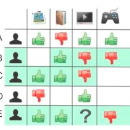Graph Convolutional Networks (GCN) have been recently employed as core component in the construction of recommender system algorithms, interpreting user-item interactions as the edges of a bipartite graph. However, in the absence of side information, the majority of existing models adopt an approach of randomly initialising the user embeddings and optimising them throughout the training process. This strategy makes these algorithms inherently transductive, curtailing their ability to generate predictions for users that were unseen at training time. To address this issue, we propose a convolution-based algorithm, which is inductive from the user perspective, while at the same time, depending only on implicit user-item interaction data. We propose the construction of an item-item graph through a weighted projection of the bipartite interaction network and to employ convolution to inject higher order associations into item embeddings, while constructing user representations as weighted sums of the items with which they have interacted. Despite not training individual embeddings for each user our approach achieves state of-the-art recommendation performance with respect to transductive baselines on four real-world datasets, showing at the same time robust inductive performance.
翻译:图卷积网络(GCN)最近已被作为构建推荐系统算法的核心组件,将用户与物品的交互解释为二分图的边。然而,在缺乏副本信息的情况下,大多数现有模型采用随机初始化用户嵌入并在训练过程中对其进行优化的方法。这种策略使这些算法天生是瞬时的,限制了它们为训练时未见的用户生成预测的能力。为了解决这个问题,我们提出了一种基于卷积的算法,从用户的角度归纳,同时仅依赖于隐式的用户-物品交互数据。我们建议通过加权投影双分图交互网络来构建物品-物品图,并采用卷积将高阶关联注入物品嵌入,同时将用户表示构造为它们与之交互的物品的加权和。尽管我们的方法不为每个用户训练单独的嵌入,但与瞬时基线相比,我们的方法在四个真实世界的数据集上实现了最先进的推荐性能,并显示了强大的归纳性能。



